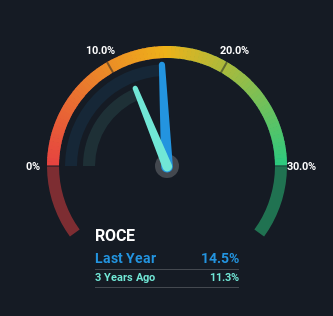Returns On Capital Signal Tricky Times Ahead For S.P. Apparels (NSE:SPAL)
If you're not sure where to start when looking for the next multi-bagger, there are a few key trends you should keep an eye out for. Firstly, we'll want to see a proven return on capital employed (ROCE) that is increasing, and secondly, an expanding base of capital employed. This shows us that it's a compounding machine, able to continually reinvest its earnings back into the business and generate higher returns. Although, when we looked at S.P. Apparels (NSE:SPAL), it didn't seem to tick all of these boxes.
Return On Capital Employed (ROCE): What Is It?
For those who don't know, ROCE is a measure of a company's yearly pre-tax profit (its return), relative to the capital employed in the business. Analysts use this formula to calculate it for S.P. Apparels:
Return on Capital Employed = Earnings Before Interest and Tax (EBIT) ÷ (Total Assets - Current Liabilities)
0.15 = ₹1.2b ÷ (₹11b - ₹3.2b) (Based on the trailing twelve months to March 2024).
Therefore, S.P. Apparels has an ROCE of 15%. In absolute terms, that's a satisfactory return, but compared to the Luxury industry average of 10% it's much better.
See our latest analysis for S.P. Apparels

Above you can see how the current ROCE for S.P. Apparels compares to its prior returns on capital, but there's only so much you can tell from the past. If you'd like to see what analysts are forecasting going forward, you should check out our free analyst report for S.P. Apparels .
What Can We Tell From S.P. Apparels' ROCE Trend?
On the surface, the trend of ROCE at S.P. Apparels doesn't inspire confidence. Around five years ago the returns on capital were 23%, but since then they've fallen to 15%. Meanwhile, the business is utilizing more capital but this hasn't moved the needle much in terms of sales in the past 12 months, so this could reflect longer term investments. It may take some time before the company starts to see any change in earnings from these investments.
Our Take On S.P. Apparels' ROCE
To conclude, we've found that S.P. Apparels is reinvesting in the business, but returns have been falling. Yet to long term shareholders the stock has gifted them an incredible 138% return in the last five years, so the market appears to be rosy about its future. Ultimately, if the underlying trends persist, we wouldn't hold our breath on it being a multi-bagger going forward.
Like most companies, S.P. Apparels does come with some risks, and we've found 1 warning sign that you should be aware of.
If you want to search for solid companies with great earnings, check out this free list of companies with good balance sheets and impressive returns on equity.
New: Manage All Your Stock Portfolios in One Place
We've created the ultimate portfolio companion for stock investors, and it's free.
• Connect an unlimited number of Portfolios and see your total in one currency
• Be alerted to new Warning Signs or Risks via email or mobile
• Track the Fair Value of your stocks
Have feedback on this article? Concerned about the content? Get in touch with us directly. Alternatively, email editorial-team (at) simplywallst.com.
This article by Simply Wall St is general in nature. We provide commentary based on historical data and analyst forecasts only using an unbiased methodology and our articles are not intended to be financial advice. It does not constitute a recommendation to buy or sell any stock, and does not take account of your objectives, or your financial situation. We aim to bring you long-term focused analysis driven by fundamental data. Note that our analysis may not factor in the latest price-sensitive company announcements or qualitative material. Simply Wall St has no position in any stocks mentioned.
Have feedback on this article? Concerned about the content? Get in touch with us directly. Alternatively, email editorial-team@simplywallst.com
About NSEI:SPAL
S.P. Apparels
Manufactures and exports knitted garments for infants and children in India and internationally.
Fair value with mediocre balance sheet.
Similar Companies
Market Insights
Community Narratives



